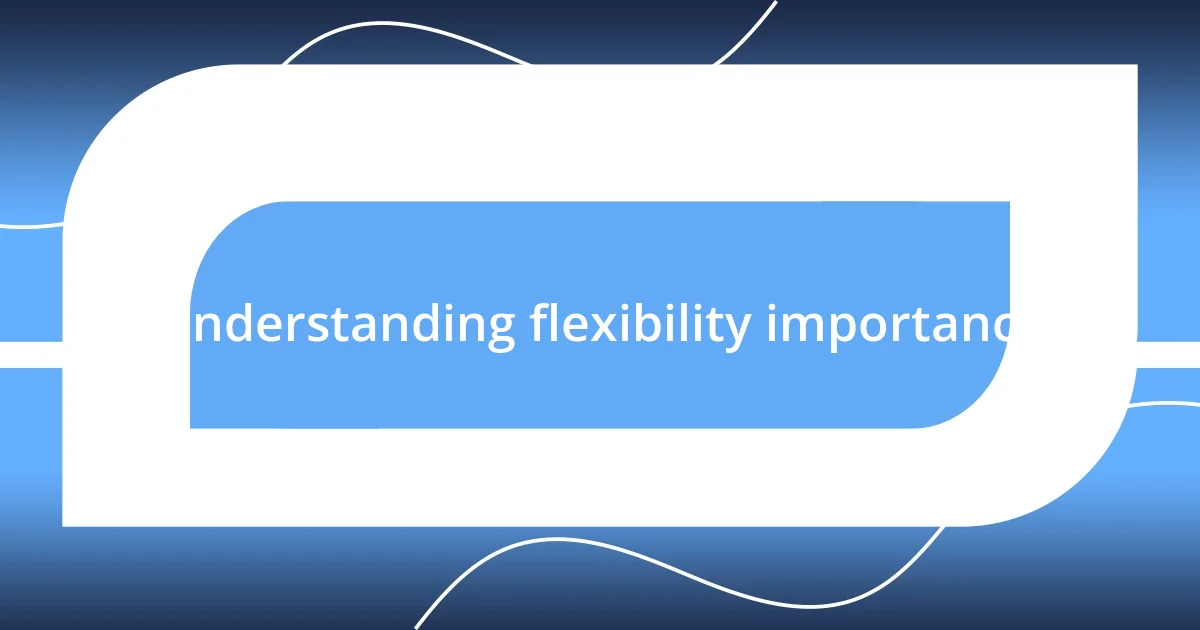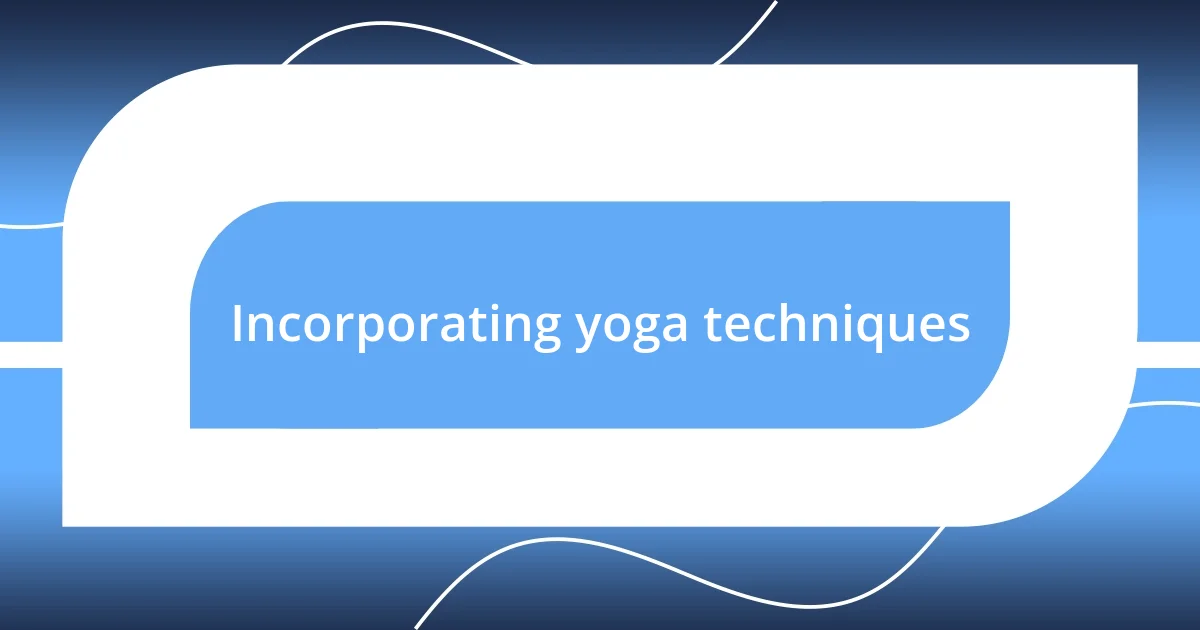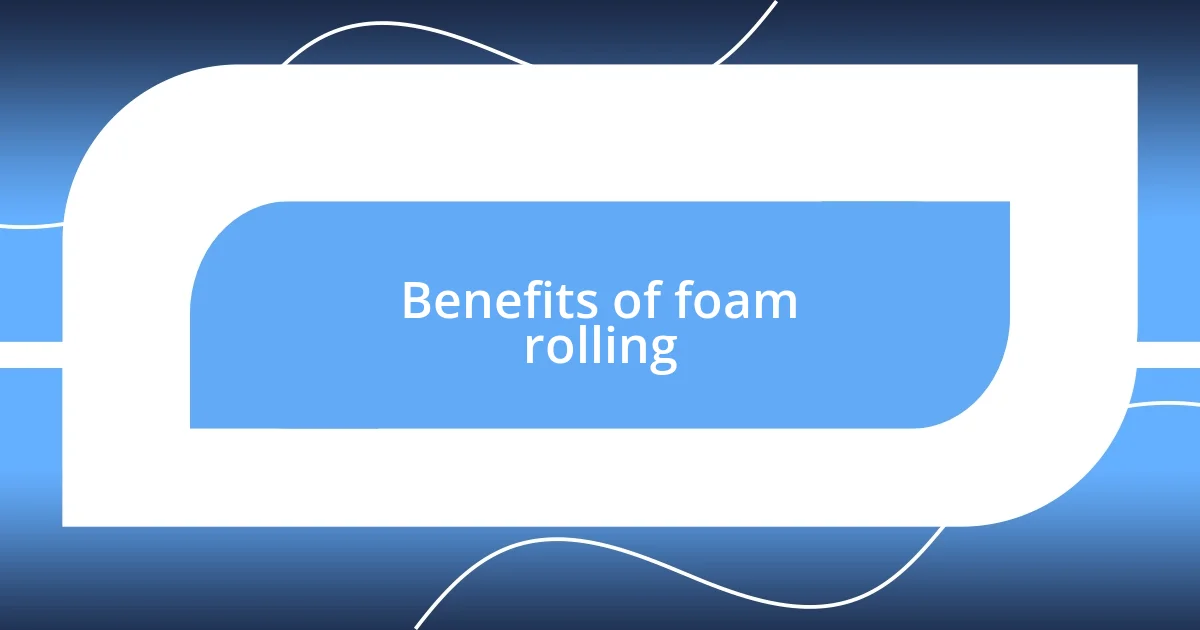Key takeaways:
- Embracing flexibility enhances personal well-being and relationships, fostering resilience in the face of life’s surprises.
- Incorporating a variety of stretching techniques into a daily routine, along with yoga practices and foam rolling, significantly improves overall flexibility and comfort.
- Tracking flexibility progress through journaling, photos, and regular assessments motivates personal growth and highlights individual improvements.

Understanding flexibility importance
Flexibility is more than just a physical ability; it’s a key component of a balanced life. I remember a time when my rigid schedule was overwhelming. A single missed appointment would send me into a tailspin, and I started to realize the stress that inflexibility created in my life. Have you ever felt that way—like the slightest disruption could unravel your entire day?
When I finally embraced the idea of flexibility, I noticed a shift in my mindset. No longer was I a slave to my plans; instead, I learned to adapt and flow with changes. One tender moment stands out: I had to forgo a planned workout to help a friend in need. It felt good to prioritize my connection with them over my routine, and I realized that true flexibility nourishes our relationships and personal well-being.
Moreover, flexibility fosters resilience. I’ve faced unexpected obstacles that required quick thinking and adaptability. The more I practiced being flexible, the better I became at navigating life’s surprises. Instead of feeling overwhelmed, I felt empowered. Isn’t it fascinating how adjusting our approach can open new doors and create opportunities we never anticipated?

Types of flexibility exercises
Flexibility exercises can be classified into several types, each serving a unique purpose. I’ve dabbled in various forms over the years, discovering how they each contribute to my overall movement quality and comfort. For instance, I once attended a yoga class that introduced me to several wonderful stretches, and I found myself leaving the class not just feeling relaxed but also surprisingly limber.
Here are some common types of flexibility exercises:
- Static Stretching: Holding a stretch for a set period, like reaching for your toes while seated.
- Dynamic Stretching: Moving parts of your body through a full range of motion, such as leg swings or arm circles.
- Ballistic Stretching: Using the momentum of a body part to force it beyond its normal range, like bouncing while stretching, but I find this one requires caution.
- PNF Stretching: Involves a partner and contraction-relaxation techniques for deeper stretches.
- Yoga: Combines stretching with strength, balance, and breathing techniques, and it’s amazing how much I gain from a good session.
- Foam Rolling: Not exactly a stretching exercise but helps release tight muscles and improve flexibility through self-myofascial release.
Each type has its charm, but I have my favorites; I feel incredibly rejuvenated after a good yoga flow or a thorough foam rolling session. It’s like giving my body a gentle reminder to loosen up after life’s daily demands.

Daily stretching routines
Daily stretching routines have become a non-negotiable part of my life. Every morning, I dedicate just ten minutes to a series of simple stretches; this small commitment yields remarkable results. I recall a day last spring, feeling tight and stiff after working long hours—my morning stretches felt like a breath of fresh air, lifting my spirits and energizing my body. Have you ever noticed how stretching can turn around an entire day? It’s as if you’re resetting your physical and mental state with every movement.
Incorporating a mix of static and dynamic stretches has proven effective for me. I often start with gentle static stretches like reaching for my toes and then move into dynamic ones, like arm swings. The transition feels effortless, and I can feel my muscles thanking me as I gently wake them up. It’s fascinating how just a few minutes of stretching can improve my posture and overall comfort throughout the day.
I’ve learned that consistency is key. I aim to follow a dedicated routine, repeating stretches that target areas where I hold tension, especially my lower back and shoulders. One memorable morning, I tried a new sequence inspired by a friend’s recommendation. It was invigorating! I felt so much release; it was like I was shedding the weight of a long week. This small change opened my eyes to the importance of tailoring routines to fit personal needs rather than sticking to a one-size-fits-all approach.
| Type of Stretch | Duration |
|---|---|
| Static Stretching | 15-30 seconds |
| Dynamic Stretching | 10-15 seconds per movement |
| Comfort Level | Gentle to moderate |
| Frequency | Daily |

Incorporating yoga techniques
One of the best ways I’ve found to incorporate yoga techniques into my routine is through proper breath awareness during stretches. The first time I really focused on my breath was during a restorative yoga session. I remember feeling overwhelmed by the demands of the week, and as I took deep, intentional breaths, it was like a wave of calm washed over me. Have you ever felt how some days you just need to pause and focus on your breathing? That connection between breath and movement enhanced my flexibility like nothing else.
Another enriching experience I’ve had was with the concept of yin yoga, which emphasizes long-held poses. I once participated in a class that held a single pose for several minutes. At first, it felt challenging, but as time passed, I discovered a deeper release in my muscles. It taught me patience and the beauty of surrendering to the stretch. I can’t help but wonder if some of us forget that flexibility isn’t always about pushing our limits; sometimes, it’s about resting in the present moment.
In addition, learning to incorporate specific yoga poses into my routine has played a significant role. For example, I’ve made it a habit to practice the downward dog each morning. I recall one morning, feeling particularly stiff, and as I transitioned into the pose, my body felt like it was finally tuning in. The elongation of my spine and the gentle tension in my legs ignited a sense of awakening. Isn’t it amazing how something as simple as a pose can reinvigorate your entire day?

Benefits of foam rolling
Foam rolling has transformed my approach to flexibility in ways I never expected. There was a time when I dismissed it as just another fitness fad, but my perspective changed after a friend encouraged me to try it. One evening, after an intense workout, I reached for the foam roller, and as I gradually rolled out the tension from my calves, it felt like ancient knots were softly unraveling. Have you ever experienced such immediate relief? That sensation was nothing short of magic!
The benefits of foam rolling go beyond mere muscle relief; it also aids in recovery. There’s a noticeable improvement in my overall flexibility, especially in my hips and lower back. Each time I roll out a tight area, it’s like sending a wave of relaxation through my body. I remember a particularly tough session where I focused on my quads and IT band. The discomfort was intense, but afterward, I felt lighter and more mobile. Isn’t it incredible how a small tool like this can enhance mobility?
I’ve also found that foam rolling has become a crucial part of my warm-up routine. By using the roller before exercising, I prepare my muscles for action, which seems to minimize soreness after workouts. I still vividly recall the first time I rolled my back before a run; the freedom in my spine made such a difference in my stride. Do you ever think about how much smoother your movements could be with a few minutes of preparation? For me, foam rolling has truly elevated my experience of physical activity.

Tracking flexibility progress
Tracking my flexibility progress has been a game-changer in my personal fitness journey. I’ve often used a simple journal to log my stretching sessions, noting down not just the duration of each stretch but also how my body felt before and after. One day, while reviewing my entries, I noticed a pattern: on days when I truly listened to my body, my flexibility improved more than on days I just went through the motions. Have you ever found that taking a moment to reflect on your progress can boost your motivation?
In addition to journaling, I’ve started taking progress photos every few weeks. I remember the first time I flipped back through those pictures; the changes in my body were both subtle and profound. It’s fascinating how visual evidence can spark such a strong sense of accomplishment! The images serve as a reminder of the journey, particularly on days when motivation wanes. Doesn’t it feel great to see just how far you’ve come, even when the scale of progress may seem small?
Lastly, I’ve incorporated flexibility testing into my routine every month. I set aside time to assess my range of motion through specific stretches and movements. I once dedicated an entire evening to this, and as I compared my results to previous months, I felt an overwhelming sense of pride. It’s like uncovering small victories that tell a bigger story of gradual improvement. How has tracking your own progress shaped your understanding of flexibility? For me, it’s more than just numbers; it’s a testament to my commitment and growth.

Common mistakes to avoid
One common mistake I’ve seen people make in their flexibility journey is rushing through stretches. I remember when I first started, I would try to whip through my routine just to say I did it. But I quickly learned that taking my time and focusing on my breath made a world of difference. Have you ever felt the difference between a rushed stretch and one where you truly connect with your body? The latter is where the magic happens.
Another pitfall is neglecting to warm up properly before diving into flexibility work. Initially, I thought jumping straight into deep stretches would yield immediate results. I’ve since learned that not prepping my muscles left me feeling tighter and more sore afterward. Now, I know that a few minutes of light activity can make my stretching sessions much more effective. Have you ever experienced stiffness that lingered because you skipped this step? Trust me, warming up sets the stage for more rewarding progress.
Lastly, I often see individuals comparing their flexibility to others too harshly. In the beginning, I was guilty of this myself, watching online videos and feeling disheartened by what seemed like everyone else’s “superhuman” ability. It wasn’t until I embraced my unique journey and celebrated my own progress—no matter how small—that I found joy in the process. Have you recognized the importance of focusing on your own improvements instead of getting lost in comparison? Acknowledging your individual milestones can truly enhance your experience and keep your motivation alive.












